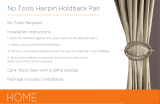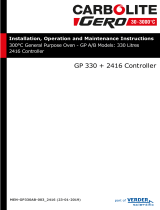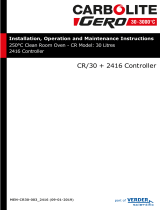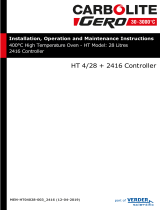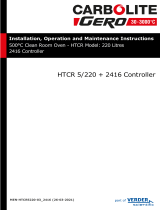
To Select Manual Mode
Press AUTO/MAN button. The MAN light comes on.
The lower readout shows the % output. The transfer from Auto to Manual is ‘bumpless’. This
means the output will remain at its current value at the point of transfer. Similarly, when
transferring from manual to auto, the current value will be used. This will then slowly change to
the value demanded automatically by the controller.
The output power changes continuously when or
are pressed.
Alarms
If the controller detects an alarm condition, it flashes an alarm message in the Home display. A new
alarm is displayed as a double flash followed by a pause, old (acknowledged) alarms as a single flash
followed by a pause. If there is more than one alarm condition, the display cycles through all the
relevant alarm messages. The table below shows a list all of the possible alarm messages and their
meanings.
Message What it means Message What it means
_FSL*
PV Full Scale Low alarm
_FL2*
Input 2 Full Scale Low alarm
_FSH*
PV Full Scale High alarm
_FH2*
Input 2 Full Scale High alarm
_dEv*
PV Deviation Band alarm
_LOP*
Working Output Low alarm
_dHi*
PV Deviation High alarm
_HOP*
Working Output High alarm
_dLo*
PV Deviation Low alarm
_LSP*
Working Setpoint Low alarm
_LCr*
Load Current Low alarm
_HSP*
Working Setpoint High alarm
_HCr*
Load Current High alarm
4rAt
PV Rate of change alarm.
Always assigned to
Alarm 4
* In place of the dash, the first character will indicate the alarm number 1, 2, 3, or 4.
Alarm acknowledgement and resetting
Pressing both and at the same time will acknowledge any new alarms and reset any latched
alarms.
Alarm modes
Alarms will have been set up to operate in one of several modes, either:
• Non-latching
,
which means that the alarm will reset automatically when the Process Value is no longer
in the alarm condition.
• Latching, which means that the alarm message will continue to flash even if the alarm condition no
longer exists and will only clear when reset.
• Blocking, which means that the alarm will only become active after it has first entered a safe state on
power-up.
• Event the alarm is used to trip an external event - the alarm message will not appear.
Diagnostic alarms
These indicate that a fault exists in either the controller or the connected devices. A list of diagnostic
alarms is given in manuals HA025132 and HA025041 which can be downloaded from
www.eurotherm.co.uk.
To Set an Alarm Threshold
Select fuLL access level - see section
Access Levels.
Press until Alarm List is displayed
Press to select the first alarm configured. This is indicated by the mnemonic shown in the table
above.
The lower display shows the alarm threshold. Press or to adjust the value.
Note: By default the Alarm List is only shown in FuLL access level, however, it is possible to ‘promote
this list to Operator level - see section
Edits Level.
In this case it is not necessary to select FuLL.
To Auto Tune the Controller
In tuning, you match the characteristics of a PID or Valve Position controller to those of the
process being controlled in order to obtain good control.
Auto Tuning automatically sets the three term parameters listed above:-
How to Tune
Select fuLL access level - see section
Access Levels.
1. Set the setpoint to the value at which you will normally operate the process.
2. In the ‘Atun’ list, select ‘tunE’ and set it to ‘on’.
3. Press the Page and Scroll buttons together to return to the Home display. The display will flash
‘tunE’ to indicate that tuning is in progress.
4. The controller induces an oscillation in the temperature by first turning the heating on, and
then off. The first cycle is not complete until the measured value has reached the required
setpoint.
5. After two cycles of oscillation the tuning is completed and the tuner switches itself off.
6. The controller then calculates the PID parameters listed above and resumes normal control
action.
See HA025132 or HA025041 for a full description of Loop Tuning.
Types of Control
The controller may be ordered (or subsequently configured) as:-
PID Order codes CC, CG, CP, P4, CM. This is a three term controller containing parameters:-
Proportional Band Pb; Integral time ti; Derivative time td; High Cutback Hcb;
Low cutback Lcb; Relative cool gain rEL
Motorised Valve Control Order codes VC, VG, VP, V4 or VM. This algorithm is designed
specifically for positioning motorised valves. It can operate in one of two ways:-
Boundless mode which does not require a feedback potentiometer, although one can be
connected and used purely to display the valve’s position.
Bounded (or position) mode which requires a feedback potentiometer. This is closed loop control
determined by the valve’s position.
These modes are set in Configuration level and are described in handbooks HA025132 and
HA025041.
See
Parameter Tables
for the list of ‘Motor’ parameters.
On/Off Control Order codes NF, NG, NP, N4, NM. The controller turns power off when the
setpoint is reached and on again when the process value falls below the setpoint (heating) or
above the setpoint (cooling).
Safety and EMC Information
This instrument is intended for industrial temperature and process control applications within the requirements of the European Directives on Safety and EMC.
The information contained in this manual is subject to change without notice. While every effort has been made to ensure the accuracy of the information, your supplier shall not be held liable for errors
contained herein.
!
The safety and EMC protection can be seriously impaired if the unit is not used in the manner specified. The installer must ensure the safety and EMC of the installation.
Safety. This instrument complies with the European Low Voltage Directive 2006/95/EC, by the application of the safety standard EN 61010.
Unpacking and storage. If on receipt, the packaging or unit is damaged, do not install but contact your supplier. If being stored before use, protect from humidity and dust in an ambient temperature
range of -20
o
C to +70
o
C.
Electrostatic discharge precautions. Always observe all electrostatic precautions before handling the unit.
Service and repair. This instrument has no user serviceable parts. Contact your supplier for repair.
Cleaning. Isopropyl alcohol may be used to clean labels. Do not use water or water based products. A mild soap solution may be used to clean other exterior surfaces.
Electromagnetic compatibility. This instrument conforms with the essential protection requirements of the EMC Directive 2004/108/EC, by the application of a Technical Construction File. It satisfies the
general requirements of the industrial environment defined in EN 61326.
Caution:
Charged capacitors. Before removing an instrument from its sleeve, disconnect the supply and wait at least two minutes to allow capacitors to discharge. Avoid touching the exposed electronics
of an instrument when withdrawing it from the sleeve.
Safety Symbols. Symbols used on the instrument have the following meaning:
!
Caution, refer to accompanying documents) Protective Conductor Terminal
Installation Category and Pollution Degree. This unit has been designed to conform to BSEN61010 installation category II and pollution degree 2, defined as follows:-
• Installation Category II (CAT II). The rated impulse voltage for equipment on nominal 230V supply is 2500V.
• Pollution Degree 2. Normally only non conductive pollution occurs. However, a temporary conductivity caused by condensation must be expected.
Personnel. Installation must only be carried out by suitably qualified personnel
Enclosure of Live Parts. To prevent hands or metal tools touching parts that may be electrically live, the controller must be installed in an enclosure.
Caution: Live sensors. The controller is designed to operate if the temperature sensor is connected directly to an electrical heating element. However, you must ensure that service personnel do not touch
connections to these inputs while they are live. With a live sensor, all cables, connectors and switches for connecting the sensor must be mains rated for use in 230Vac +15% CATII.
Wiring. It is important to connect the unit in accordance with the data in this sheet ensuring that the protective earth connection is ALWAYS fitted first and disconnected last. Wiring must comply with all
local wiring regulations, i.e. UK, the latest IEE wiring regulations, (BS7671), and USA, NEC Class 1 wiring methods.
!
Do not connect AC supply to low voltage sensor input or low level inputs and outputs.
Voltage rating. The maximum continuous voltage applied between any of the following terminals must not exceed 230Vac +15%.
• relay output to logic, dc or sensor connections;
• any connection to ground.
The controller must not be wired to a three phase supply with an unearthed star connection. Under fault conditions such a supply could rise above 230Vac with respect to ground and the product would
not be safe.
Conductive pollution. Electrically conductive pollution i.e. carbon dust, MUST be excluded from the enclosure in which the controller is installed. To secure a suitable atmosphere in conditions of
conductive pollution, fit an air filter to the air intake of the enclosure. Where condensation is likely, include a thermostatically controlled heater in the enclosure.
Grounding of the temperature sensor shield. In some installations it is common practice to replace the temperature sensor while the controller is still powered up. Under these conditions, as additional
protection against electric shock, we recommend that the shield of the temperature sensor is grounded. Do not rely on grounding through the framework of the machine.
Parameter Mnemonic and
Description
Setting for the
above example
Prgn
Program Number. 4
or 20 program
controllers only.
Between 1 and 20.
Hb
Holdback
(configured for
whole program)
OFF
Hb V
Holdback value
0.0
rmP.U
Ramp units
SEc (seconds)
dwL.U
Dwell units
Min (minutes)
CYC.n
Program cycles
1
Seg.n
Segment number
1
type
Segment 1 Type
rmP.r (Ramp Rate)
tgt
Target Setpoint
100 (
O
C)
rate
Ramp Rate
5.0 (
O
C/second)
out1
Event output 1
on
out1/8
Event outputs 2 to 8
OFF
Seg.n
Segment 2
2
type
Segment 2 Type
dweLL
dur
Duration
60.0
out1
Event output 1
OFF
out1/8
Event outputs 2 to 8
OFF
Seg.n
Segment 3
3
type
Segment 3 Type
step
tgt
Target Setpoint
40.0
Seg.n
Segment 4
4
type
Segment 4 Type
end
End.t
End Type
dweLL
Access Levels
There are four access levels:
• Operator level, operators can view and adjust the value of parameters defined in
Edit Level.
• Full level, all parameters relevant to a particular configuration are visible. All
alterable parameters may be adjusted. Generally used to commission the
controller.
• Edit level, is used to set up the parameters that you want an operator to be able
to see and adjust when in Operator level.
• Configuration level, is used to set up the fundamental characteristics of the
controller.
Access to, Full, Edit and Configuration levels is protected by security codes. For
Full and Edit the code is set to ‘1’ when the controller is shipped from the factory.
For Configuration refer to manuals HA025132 and HA025041.
To Select an Access Level
1. Press to select accs List.
2. Press to select code
3. Press or to enter the security code. pass is displayed if the code
is correct or the display will remain at ‘code’ if the password is incorrect
4. Press to select goto
5. Press or to select FuLL or edit.
Edit Level
Edit level is used to set which parameters you can view and adjust in Operator
level. It also gives access to the ‘Promote’ feature, which allows you to select and
add (‘Promote’) up to twelve parameters into the Home display list, thereby giving
simple access to commonly used parameters.
Having selected the required parameter, use or to set its availability in
Operator level.
Each parameter can be set to:
ALtr - makes a parameter alterable in Operator level.
PrO - Promotes a parameter into the Home display list.
rEAd - Makes a parameter, or list header, read-only
(it can be viewed but not
altered).
HIdE - Hides a parameter, or list header.
Returning to Operator Level
To return to operator level from either ‘FuLL’ or ‘Edit’ level, repeat entry of the
password and select ‘OPEr’ on the ‘Goto’ display.
In ‘Edit’ level, the controller will automatically return to operator level if no button
is pressed for 45 seconds.
Example: To Run/Hold/Reset a Program
If you are using a 4, or 20, program version of the
controller, you must first select the number of the
program that you want to run. Do this in the ‘run’
list.
Then press
• Press once to run a program (RUN light on)
• Press again to hold a program (HOLD light on)
• Press again to cancel hold and continue running
(HOLD light off, RUN light on)
• Press and hold in for two seconds to reset a
program (RUN and HOLD lights off).
The RUN/HOLD button can be disabled, either
when ordering the controller, or subsequently in
configuration - see Handbooks HA025132 and
HA025041. This will force you to operate the
programmer from the ‘run’ list all the time. Select
parameter stat and set this to run, hoLd or OFF.
The main advantage of this method is that it will
reduce the chance of accidentally changing the
state of the program.
Example: To Create or Edit a Program
This example shows how the operator buttons are
used to set up a simple ramp/dwell/step program.
Refer also to the Parameter Tables - Program Edit List.
A program can only be edited when it is in Reset or
Hold.
Press to select Prog List.
Press to select parameters
Press or to change parameter values
60m
5
O
C/s
Step
End
Event Output 1
Event Outputs
2 to 8
On
Off
Off
Over Temperature Protection.
To prevent overheating of the process under fault conditions, a separate over-temperature protection unit should be fitted which will isolate the heating circuit. This must have an independent
temperature sensor.
Note: Alarm relays within the unit will not give protection under all failure conditions.
Installation Requirements for EMC. To comply with European EMC directive certain installation precautions are necessary:-
• General guidance. Refer to
EMC Installation Guide
, Part no. HA025464.
• Relay outputs. It may be necessary to fit a suitable filter to suppress conducted emissions. Filter requirements depend on the type of load.
• Table top installation. If using a standard power socket, compliance with commercial and light industrial emissions standard is usually required. To comply with conducted emissions standard, a
suitable mains filter must be installed.
Manufacturing Address Sales and Service
U.K. Worthing Eurotherm Ltd
Eurotherm Ltd Faraday Close
Telephone (+44) 1903 268500 Worthing
Fax (+44 01903) 265982 West Sussex BN13 3PL
Fax (+44 01903) 265982
Web www.eurotherm.co.uk E-mail info.uk@eurotherm.com
Invensys, Eurotherm, the Eurotherm logo, Chessell, EurothermSuite, Mini8, Eycon, Eyris and
Wonderware are trademarks on Invensys plc, its subsidiaries and affiliates. All other brands
may be trademarks of their respective owners.
© Copyright Eurotherm Ltd
TM
2013
All rights are strictly reserved. No part of this document may be reproduced, modified or
transmitted in any form by any means, nor may it be stored in a retrieval system other than for
the purpose to act as an aid in operating the equipment to which the document relates,
without the prior written permission of Eurotherm.
Eurotherm pursues a policy of continuous development and product improvement. The
specification in this document may, therefore, change without notice. The information in this
document is given in good faith, but it is intended for guidance only. Eurotherm will accept
no responsibility for any loses arising from errors in this document.
Product group
2400
Table listing restricted substances
Chinese
2400
XOO O O O
附属物 OOO O O O
显示器 XOO O O O
模块 XOX O O O
O
X
English
Product
2400
Pb Hg Cd Cr(VI) PBB PBDE
PCBA X O O O O O
Enclosure O O O O O O
Display X O O O O O
Modules X O X O O O
O
X
Approval
Name: Position: Signature: Date:
Martin Greenhalgh Quality Manager
IA029470U470 (CN23172) Issue 1 Feb 07
Indicates that this toxic or hazardous substance contained in at least one of the homogeneous
materials used for this part is above the limit requirement in SJ/T11363-2006.
表示该有毒有害物质至少在该部件的某一均质材料中的含量超出
SJ/T11363-2006
标准规定的限量要求。
Toxic and hazardous substances and elements
Indicates that this toxic or hazardous substance contained in all of the homogeneous materials for
this part is below the limit requirement in SJ/T11363-2006.
Restricted Materials Table
Restriction of Hazardous Substances (RoHS)
表示该有毒有害物质在该部件所有均质材料中的含量均在
SJ/T11363-2006
标准规定的限量要求以下。




